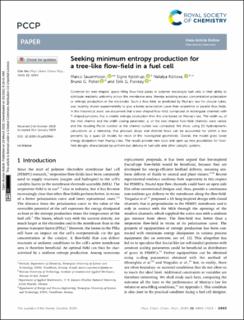| dc.contributor.author | Sauermoser, Marco | |
| dc.contributor.author | Kjelstrup, Signe | |
| dc.contributor.author | Kizilova, Nataliya | |
| dc.contributor.author | Pollet, Bruno | |
| dc.contributor.author | Flekkøy, Eirik Grude | |
| dc.date.accessioned | 2021-03-01T09:20:18Z | |
| dc.date.available | 2021-03-01T09:20:18Z | |
| dc.date.created | 2020-03-19T15:08:29Z | |
| dc.date.issued | 2020 | |
| dc.identifier.citation | Physical Chemistry, Chemical Physics - PCCP. 2020, 22 6993-7003. | en_US |
| dc.identifier.issn | 1463-9076 | |
| dc.identifier.uri | https://hdl.handle.net/11250/2730829 | |
| dc.description.abstract | Common for tree-shaped, space-filling flow-field plates in polymer electrolyte fuel cells is their ability to distribute reactants uniformly across the membrane area, thereby avoiding excess concentration polarization or entropy production at the electrodes. Such a flow field, as predicted by Murray's law for circular tubes, was recently shown experimentally to give a better polarization curve than serpentine or parallel flow fields. In this theoretical work, we document that a tree-shaped flow-field, composed of rectangular channels with T-shaped junctions, has a smaller entropy production than the one based on Murray's law. The width w0 of the inlet channel and the width scaling parameter, a, of the tree-shaped flow-field channels were varied, and the resulting Peclet number at the channel outlets was computed. We show, using 3D hydrodynamic calculations as a reference, that pressure drops and channel flows can be accounted for within a few percents by a quasi-1D model, for most of the investigated geometries. Overall, the model gives lower energy dissipation than Murray's law. The results provide new tools and open up new possibilities for flow-field designs characterized by uniform fuel delivery in fuel cells and other catalytic systems. | en_US |
| dc.language.iso | eng | en_US |
| dc.publisher | Royal Society of Chemistry | en_US |
| dc.rights | Navngivelse 4.0 Internasjonal | * |
| dc.rights.uri | http://creativecommons.org/licenses/by/4.0/deed.no | * |
| dc.title | Seeking minimum entropy production for a tree-like flow-field in a fuel cell | en_US |
| dc.type | Peer reviewed | en_US |
| dc.type | Journal article | en_US |
| dc.description.version | publishedVersion | en_US |
| dc.source.pagenumber | 6993-7003 | en_US |
| dc.source.volume | 22 | en_US |
| dc.source.journal | Physical Chemistry, Chemical Physics - PCCP | en_US |
| dc.identifier.doi | 10.1039/C9CP05394H | |
| dc.identifier.cristin | 1802478 | |
| dc.relation.project | Norges forskningsråd: 262644 | en_US |
| cristin.ispublished | true | |
| cristin.fulltext | postprint | |
| cristin.qualitycode | 2 | |

